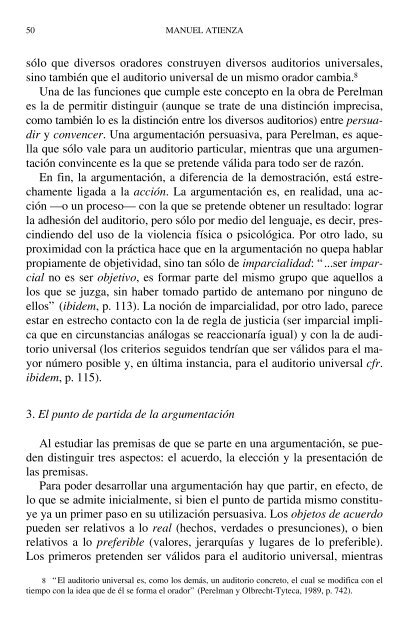LAS RAZONES DEL DERECHO Teo rías de la ar gu men ta ción ju rí di ca
You also want an ePaper? Increase the reach of your titles
YUMPU automatically turns print PDFs into web optimized ePapers that Google loves.
50 MANUEL ATIENZA<br />
sólo que <strong>di</strong>versos oradores construyen <strong>di</strong>versos au<strong>di</strong>torios universales,<br />
sino <strong>ta</strong>mbién que el au<strong>di</strong>torio universal <strong>de</strong> un mismo orador <strong>ca</strong>mbia. 8<br />
Una <strong>de</strong> <strong>la</strong>s funciones que cumple este concepto en <strong>la</strong> obra <strong>de</strong> Perelman<br />
es <strong>la</strong> <strong>de</strong> permitir <strong>di</strong>stin<strong>gu</strong>ir (aunque se trate <strong>de</strong> una <strong>di</strong>stin<strong>ción</strong> imprecisa,<br />
como <strong>ta</strong>mbién lo es <strong>la</strong> <strong>di</strong>stin<strong>ción</strong> entre los <strong>di</strong>versos au<strong>di</strong>torios) entre persua<strong>di</strong>r<br />
y convencer. Una <strong>ar</strong><strong>gu</strong><strong>men</strong><strong>ta</strong><strong>ción</strong> persuasiva, p<strong>ar</strong>a Perelman, es aquel<strong>la</strong><br />
que sólo vale p<strong>ar</strong>a un au<strong>di</strong>torio p<strong>ar</strong>ticu<strong>la</strong>r, mientras que una <strong>ar</strong><strong>gu</strong><strong>men</strong><strong>ta</strong><strong>ción</strong><br />
convincente es <strong>la</strong> que se preten<strong>de</strong> válida p<strong>ar</strong>a todo ser <strong>de</strong> razón.<br />
En fin, <strong>la</strong> <strong>ar</strong><strong>gu</strong><strong>men</strong><strong>ta</strong><strong>ción</strong>, a <strong>di</strong>ferencia <strong>de</strong> <strong>la</strong> <strong>de</strong>mostra<strong>ción</strong>, está estrecha<strong>men</strong>te<br />
ligada a <strong>la</strong> ac<strong>ción</strong>. La <strong>ar</strong><strong>gu</strong><strong>men</strong><strong>ta</strong><strong>ción</strong> es, en realidad, una ac<strong>ción</strong><br />
—o un proceso— con <strong>la</strong> que se preten<strong>de</strong> obtener un resul<strong>ta</strong>do: logr<strong>ar</strong><br />
<strong>la</strong> adhesión <strong>de</strong>l au<strong>di</strong>torio, pero sólo por me<strong>di</strong>o <strong>de</strong>l len<strong>gu</strong>aje, es <strong>de</strong>cir, prescin<strong>di</strong>endo<br />
<strong>de</strong>l uso <strong>de</strong> <strong>la</strong> violencia físi<strong>ca</strong> o psicológi<strong>ca</strong>. Por otro <strong>la</strong>do, su<br />
proximidad con <strong>la</strong> prácti<strong>ca</strong> hace que en <strong>la</strong> <strong>ar</strong><strong>gu</strong><strong>men</strong><strong>ta</strong><strong>ción</strong> no quepa hab<strong>la</strong>r<br />
propia<strong>men</strong>te <strong>de</strong> objetividad, sino <strong>ta</strong>n sólo <strong>de</strong> imp<strong>ar</strong>cialidad: “...ser imp<strong>ar</strong>cial<br />
no es ser objetivo, es form<strong>ar</strong> p<strong>ar</strong>te <strong>de</strong>l mismo grupo que aquellos a<br />
los que se <strong>ju</strong>zga, sin haber tomado p<strong>ar</strong>tido <strong>de</strong> antemano por nin<strong>gu</strong>no <strong>de</strong><br />
ellos” (ibi<strong>de</strong>m, p. 113). La no<strong>ción</strong> <strong>de</strong> imp<strong>ar</strong>cialidad, por otro <strong>la</strong>do, p<strong>ar</strong>ece<br />
est<strong>ar</strong> en estrecho con<strong>ta</strong>cto con <strong>la</strong> <strong>de</strong> reg<strong>la</strong> <strong>de</strong> <strong>ju</strong>sticia (ser imp<strong>ar</strong>cial impli<strong>ca</strong><br />
que en circuns<strong>ta</strong>ncias análogas se reaccion<strong>ar</strong>ía i<strong>gu</strong>al) y con <strong>la</strong> <strong>de</strong> au<strong>di</strong>torio<br />
universal (los criterios se<strong>gu</strong>idos tend<strong>rí</strong>an que ser válidos p<strong>ar</strong>a el mayor<br />
número posible y, en última ins<strong>ta</strong>ncia, p<strong>ar</strong>a el au<strong>di</strong>torio universal cfr.<br />
ibi<strong>de</strong>m, p. 115).<br />
3. El punto <strong>de</strong> p<strong>ar</strong>tida <strong>de</strong> <strong>la</strong> <strong>ar</strong><strong>gu</strong><strong>men</strong><strong>ta</strong><strong>ción</strong><br />
Al estu<strong>di</strong><strong>ar</strong> <strong>la</strong>s premisas <strong>de</strong> que se p<strong>ar</strong>te en una <strong>ar</strong><strong>gu</strong><strong>men</strong><strong>ta</strong><strong>ción</strong>, se pue<strong>de</strong>n<br />
<strong>di</strong>stin<strong>gu</strong>ir tres aspectos: el acuerdo, <strong>la</strong> elec<strong>ción</strong> y <strong>la</strong> presen<strong>ta</strong><strong>ción</strong> <strong>de</strong><br />
<strong>la</strong>s premisas.<br />
P<strong>ar</strong>a po<strong>de</strong>r <strong>de</strong>s<strong>ar</strong>rol<strong>la</strong>r una <strong>ar</strong><strong>gu</strong><strong>men</strong><strong>ta</strong><strong>ción</strong> hay que p<strong>ar</strong>tir, en efecto, <strong>de</strong><br />
lo que se admite inicial<strong>men</strong>te, si bien el punto <strong>de</strong> p<strong>ar</strong>tida mismo constituye<br />
ya un primer paso en su utiliza<strong>ción</strong> persuasiva. Los objetos <strong>de</strong> acuerdo<br />
pue<strong>de</strong>n ser re<strong>la</strong>tivos a lo real (hechos, verda<strong>de</strong>s o presunciones), o bien<br />
re<strong>la</strong>tivos a lo preferible (valores, jer<strong>ar</strong>quías y lug<strong>ar</strong>es <strong>de</strong> lo preferible).<br />
Los primeros preten<strong>de</strong>n ser válidos p<strong>ar</strong>a el au<strong>di</strong>torio universal, mientras<br />
8 “El au<strong>di</strong>torio universal es, como los <strong>de</strong>más, un au<strong>di</strong>torio concreto, el cual se mo<strong>di</strong>fi<strong>ca</strong> con el<br />
tiempo con <strong>la</strong> i<strong>de</strong>a que <strong>de</strong> él se forma el orador” (Perelman y Olbrecht-Tyte<strong>ca</strong>, 1989, p. 742).



